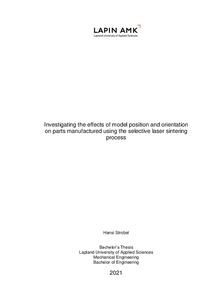Investigating the effects of model position and orientation on parts manufactured using the selective laser sintering process
Strobel, Hansi (2021)
Strobel, Hansi
2021
All rights reserved. This publication is copyrighted. You may download, display and print it for Your own personal use. Commercial use is prohibited.
Julkaisun pysyvä osoite on
https://urn.fi/URN:NBN:fi:amk-202105118173
https://urn.fi/URN:NBN:fi:amk-202105118173
Tiivistelmä
This work aims to explore the influence of part position and orientation within the build volume of selective laser sintering machines on visual part quality and tensile properties. This is done in an attempt to optimize both machine time and manufacturing costs. Furthermore, students and staff at the Lapland University of Applied Sciences are introduced to the workflow around the novel selective laser sintering machine found in the Lapland University of Applied Sciences 3D printing laboratory.
In a first set of experiments, it was discovered that the position and orientation of parts within the build volume of selective laser sintering machines plays a crucial role in the success of a manufacturing run. Incorrect positioning may lead to warping or severe alteration of part geometry.
Further experiments revealed that tensile specimens manufactured in different positions and orientations show similar behaviour in the elastic region but differ in their behaviour in the plastic region. Significant anisotropy between specimen orientations was discovered. Specimens manufactured perpendicularly to the build direction show a 50 % reduction in elongation at break and 25 % reduction in ultimate tensile strength compared to specimens manufactured parallel to the build direction.
Moreover, it was discovered that high model densities and fast layer times lead to local hot spots, resulting in part growth due to amplified secondary sintering effects. Increased part growth was observed in the first layers as a result of increased temperatures caused by the employed method of build volume heating. Furthermore, specimens which experienced overheating during the build stage showed a significant improvement in their tensile properties.
In a first set of experiments, it was discovered that the position and orientation of parts within the build volume of selective laser sintering machines plays a crucial role in the success of a manufacturing run. Incorrect positioning may lead to warping or severe alteration of part geometry.
Further experiments revealed that tensile specimens manufactured in different positions and orientations show similar behaviour in the elastic region but differ in their behaviour in the plastic region. Significant anisotropy between specimen orientations was discovered. Specimens manufactured perpendicularly to the build direction show a 50 % reduction in elongation at break and 25 % reduction in ultimate tensile strength compared to specimens manufactured parallel to the build direction.
Moreover, it was discovered that high model densities and fast layer times lead to local hot spots, resulting in part growth due to amplified secondary sintering effects. Increased part growth was observed in the first layers as a result of increased temperatures caused by the employed method of build volume heating. Furthermore, specimens which experienced overheating during the build stage showed a significant improvement in their tensile properties.
